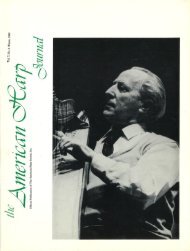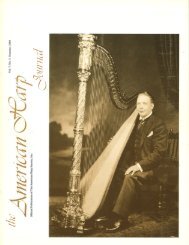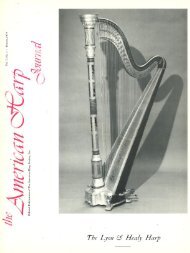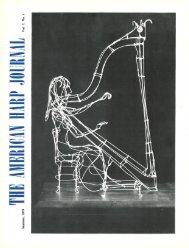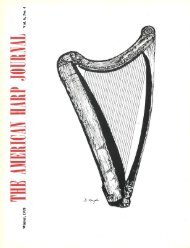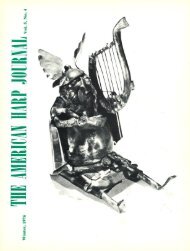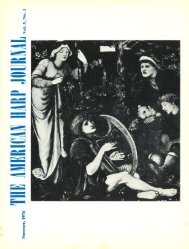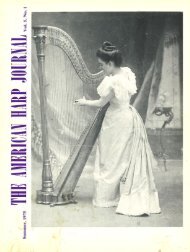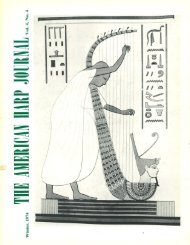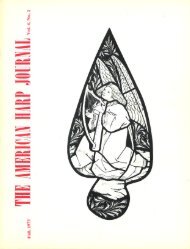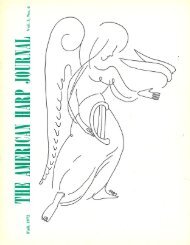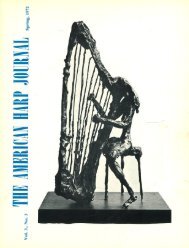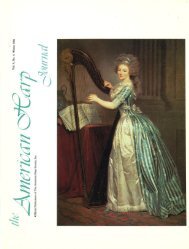Create successful ePaper yourself
Turn your PDF publications into a flip-book with our unique Google optimized e-Paper software.
tic instrument conceived by Parish-Alvars (see examples<br />
8a and 8b).<br />
The Rondo, whose theme is charming, has three<br />
cadenzas, each preceding a repetition of the melody.<br />
From this point the compositions of Petrini gave the<br />
harp a fresh impetus. These works, published for the<br />
most part during the Revolution and in the beginning of<br />
the 19th Century, somewhat exceed the limits of this<br />
article. However, two works must be cited as particularly<br />
interesting: the Third Duo for Two Harps ( or Harp<br />
and Violin) with Accompaniment of Violin and Bass<br />
ad lib., dedicated to the Citizen Archinard, Op. XXXI<br />
and the 4 Symphonies for Harp (Op. XXXVI) with<br />
Accompaniment of I Flute, 2 Violins, 2 Horns and 1<br />
Bass.<br />
But-let us turn back. There is perhaps an explanation<br />
for these contrasting aspects of the same composer.<br />
The mediocre Petrini of the first years was above all a<br />
courtier eager to gain a reputation. As a protege of<br />
Mme. de Genlis, it seems that his compositions at this<br />
period had the single aim of pleasing a public of amateurs.<br />
His early efforts were dedicated to melodies with<br />
variations and ariettas with harp accompaniment. We<br />
find later in Petrini this same opportunism which led<br />
him to write at the end of the Revolution some variations<br />
on "The Awakening of the People" by Gaveaux,<br />
which, after Thermidor, saluted the end of the terror.<br />
[Pierre Gaveaux (1761-1825): Tenor and Composer of<br />
thirty-three operas. Thermidor: Eleventh month of the<br />
calendar of the first French Republic, July 19-August<br />
17-Ed.] Under the Empire he published a "Battle of<br />
Wagram" for harp, which is rather astonishing; and<br />
under the Restoration some variations on Long live<br />
Henri IV!" Petrini died in 1819; if he had not, political<br />
events in France doubtless would have inspired other<br />
pages, all equally curious.<br />
Mme. de Genlis had invented a technique which had<br />
no success: she sanctioned the use of the little finger.<br />
This position forced the harpist to invert the hand completely,<br />
and deprived him of adequate strength to pluck<br />
the strings. In the book of sonatas (Op. IV) dedicated<br />
to the Countess of Genlis, and also in Op. X, Three<br />
Airs and Variations and 2 Sonatas Dedicated to Her<br />
Serene Highness Mademoiselle [The title "Mademoiselle"<br />
designated the eldest sister of the king of France<br />
-Ed.] of which the first "air varie" is by Mme. la<br />
Marquise de Sillery, (Mme. de Genlis), Petrini uses the<br />
little finger, and boasts in the dedicatory letter: "I have<br />
composed music suitable to the new method which<br />
Mme. la Marquise de Sillery uses with so much success<br />
in playing the harp, and which she has taught to your<br />
Serene Highness."<br />
At the same time it must be observed that the compositions<br />
of Petrini destined for his own personal use<br />
avoid using the five fingers ...<br />
It is practically impossible to compile a catalogue of<br />
works for harp in an era when music publication was<br />
abundant. In 1784 Roze de Chantoiseau in the Register<br />
of Famous Musicians lists 5 8 professors of harp in Paris<br />
alone, almost all of whom had, at least at one time, the<br />
18<br />
desire to see engraved in this list the result of their<br />
inspiration.<br />
Amid this multitude of minor works there are some<br />
which are musically agreeable, but which do not advance<br />
the technique of the instrument. The following<br />
may be mentioned:<br />
Antoine de Mignaux, who in 1774 published Sonatas<br />
en trio pour harpe, violin, and clavichord, which he<br />
changed into quartets the following year by adding a<br />
viola part, but which has been lost. These sonatas are<br />
dedicated to the Dauphine Marie-Antoinette and to<br />
Mme. Elisabeth. Technically easy, they were no doubt<br />
played by their illustrious patronesses. Johann Schobert<br />
wrote 2 sonatas for harp with accompaniment of violin.<br />
All that can be said of these works is that their composer<br />
seems to have been more inspired in his works for<br />
harpsichord.<br />
Philippe-Joseph Hinner, a pupil of Petrini, born at<br />
Wetzlar in 1754, made his debut at the Concert Spirituel<br />
with the flutist Sallentin. Teacher of Marie-Antoinette,<br />
he dedicated to the Queen in 1775 some sonatas whose<br />
charming titles transport the listener to the shades of the<br />
Trianon merely by reading them; they are: Haughtiness,<br />
The River, The Chatterer, Sophie, The Village Woman<br />
...<br />
Antoine-Jean Gros, musician for Frederic II, established<br />
as professor of harp in Paris in 1 780, published<br />
4 Sonatas en trio for Harp, Violin and Violoncello. He<br />
is a little known composer, whose elegance and style deserve<br />
a better fate.<br />
In 1784, Francois-Joseph Ferdinand Herold (father<br />
of the composer of The Priests' Meadow), although he<br />
was not a harpist, published 4 Sonatas en trio for Harp,<br />
Violin and Violoncello which are extremely interesting.<br />
Mlle. Duverger (wife of J.-B. Anet, called Clery,<br />
valet de chambre of Louis XVI) harpist to the Queen,<br />
was reckoned among the best soloists in Paris, and in<br />
1791 the Register of the Famous alloted to her several<br />
flattering lines: "She played at the Concert Spirituel<br />
several sonatas and a concerto by M. Bach with a taste,<br />
an ease and a precision which won for her the most<br />
enthusiastic applause."<br />
Mme. Clery left a volume of sonatas dedicated to the<br />
queen, more remarkable for their feeling than for their<br />
inspiration.<br />
Patouart fils, a celebrated guitarist, composed a Sonata<br />
for Harp Solo ( in B Flat), well written, consisting<br />
of an allegro and a minuet with its double.<br />
Finally, an amateur, Louis-Charles Rague, left 3 Sonatas<br />
for Harp and Clavichord which, if they add nothing<br />
to technique, have some charming pages. Rague<br />
published also an Art de preluder sur la harpe, which is<br />
not without interest.<br />
One harpist-composer carried into the 19th Century<br />
the technique and the music of the harp from the preceding<br />
century: Francois-Joseph Nadermann. He was<br />
the son of a harp maker for Marie-Antoinette, which<br />
explains why numerous programs and announcements<br />
put Nadermann in the 18th Century, whereas his activities<br />
extended from 1815 to 1835.<br />
AMERICAN HARP JOURNAL




